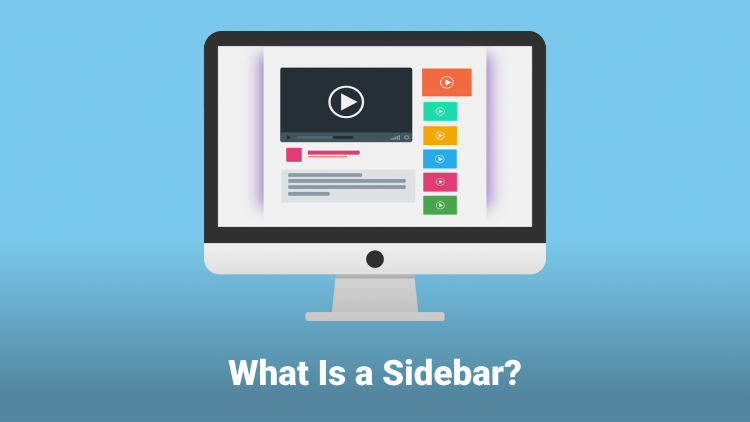What Is a Sidebar? Beginner’s Guide in 2023
- What are sidebars?
- What is the use of a sidebar?
- Right vs left sidebar
- Importance of sidebars
- Modify what is located in the sidebar
- Conclusion
What is a sidebar? It is a commonly used element on numerous websites, because they offer an area to present extra content and features.
Whether you’re a web designer or a user seeking further insights into sidebars, join us to explore how this element can elevate your website’s capabilities.
What are they?
Firstly a sidebar is a vertical column that you can find on the side of a webpage or blog. They provide extra information to users.
It is commonly present on every page of a website and incorporates various elements such as a search bar, recent posts, popular posts, categories, tags, social media links, advertisements, and other widgets.
These additions aim to enhance the user experience and facilitate navigation options. Therefore they make it easier for users to explore and interact with the website.
For instance, on our blog page, you can find the Latest posts and a link to Create a free account on Trustindex.

The purpose of a sidebar is to enhance the main content of a website and provide users with convenient access to information and tools.
While the specific design and layout of a sidebar may differ based on the website’s design and objectives, its primary function remains consistent—to complement the main content and offer users a seamless way to retrieve the desired information and utilize various tools.
What Are They Used for?
By showing links to popular or related content, they motivate individuals to delve deeper into a website, therefore they encourage thorough exploration. Users can click on these links and access additional articles, leading to increased page views and extended time spent on the website.
Sidebars are widely available on websites for a multitude of purposes. Below are several prevalent applications of this useful element:
- Searches
- Call to action
- Related content
- Author information
- Navigation
- Social media links
- Advertisements
- Contact information
Left sidebar vs right sidebars
There can be multiple sidebars on a website, one for navigation and one for advertising or for the latest articles, short news story, and email subscription forms.
Left sidebars: used for navigation, housing categories, archives, social media links, and additional supporting content. They are also designated for website or WordPress widgets. Positioned near the top left of the page, left sidebars offer convenient access to users.
Right sidebars: frequently employed for promotional or advertising goals. They showcase advertisements, call-to-action buttons, and links to sponsored content, generating revenue for the website. Additionally, in online magazines, the right sidebars can present related content, a major story, social media links, or recommended articles like on the website of The New York Times.
Importance of a Sidebar
A Sidebar is similar to a map’s importance, website navigation plays a pivotal role in guiding users. Therefore effective website navigation enables users to effortlessly locate the desired information, explore the site’s offerings, and take desired actions.
Users can click on these links in the sidebar to access additional articles, leading to increased page views and more time spent on the website.
Modify What is Located in the Sidebar
To modify the content in a sidebar, follow these steps:
- Log in to the website’s content management system (CMS) or website builder by accessing the dashboard or backend interface.
- Navigate to the specific section of the CMS or website builder that governs the sidebar content. This section is usually found as “sidebar,” “widgets,” or something similar.
- Utilize the tools provided by the CMS or website builder to make changes to the widgets within the sidebar. You can add, delete, or rearrange the widgets according to your preferences.
- Preview the modifications to ensure that they are displayed as intended within the sidebar. This step allows you to see how the changes will appear to visitors.
- Once you are satisfied with the changes, save or publish them to make them live on the website for all users to see.
The process of modifying sidebar content vary in complexity. It depends on the website’s design and the CMS or website builder. However, by following these general steps, you can efficiently manage and customize the content within the sidebar.
Conclusion
In conclusion, the sidebar serves as a versatile and valuable component of a website, contributing to its overall functionality and user experience.
By providing supplementary content, facilitating navigation, and enhancing accessibility to important information, this element plays a crucial role in guiding users and enhancing their engagement.
Whether it’s displaying related articles, showcasing widgets, or housing promotional elements, a well-designed sidebar can significantly impact the success of a website. As web designers and users alike, understanding the significance of the sidebar empowers us to leverage its potential and create engaging and user-friendly digital experiences.
If you are creating your website and want to know how to edit the footer section read this article on our blog.
FAQ
The main purpose of a sidebar is to enhance the user experience by offering quick access to relevant information, navigation options, and tools without obstructing the main content. It can also serve to promote related content, advertisements, or social media links.
Sidebars are not mandatory for all websites. Their use depends on the specific goals, content, and web design. Some websites may choose not to include it, opting for a simpler or more streamlined layout. The decision to include it should be based on the website’s requirements and the optimal user experience. In today’s mobile-first world these elements are often hidden for the users on mobile devices.
A well-designed sidebar can enhance a website by providing easy navigation, quick access to important information, and improved user engagement. It can help users find what they’re looking for more efficiently, promote related content or products, and reinforce branding and personality.
